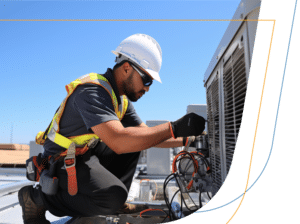

BLOG
Beyond Functionality: How Proper HVAC Maintenance Ensures Healthy Occupancy Conditions
4/16/25
When most people think of HVAC maintenance, they picture technicians changing filters, checking refrigerant levels, and cleaning coils to keep the system operational and to prevent expensive failures. While these are basic and essential goals of effective HVAC maintenance, additional diligence and expertise is required to sustain a healthy, comfortable indoor environment for building occupants.
Operating Sequences: The Foundation of Comfort and Efficiency
An HVAC system’s operating sequence defines how and when the system activates heating, cooling, and ventilation cycles. Improper or inefficient operating sequences can lead to poor indoor air quality, uneven temperature distribution, and increased energy consumption. Manual overrides are a common problem with HVAC controls that can result in the improper mix of indoor and outdoor air being introduced into the space, excessive operation during unoccupied hours, and comfort issues. Controlling building pressure helps to limit outside air contaminants and moisture from entering. Proper ductwork supply air pressure prevents over/under-cooling issues and saves fan energy. Programming systems to control outside air dampers based on CO2 levels (demand-controlled ventilation) will maintain safe conditions. And proper temperature set points and schedules ensure consistently comfortable and healthy conditions.
Sensor Calibration: The Key to Accurate Environmental Control
Air Quality and Filtration: A Direct Impact on Health
Preventing Mold and Moisture Buildup
Conclusion: A Holistic Approach to HVAC Maintenance
It’s important to remember that HVAC systems are carefully designed to meet the requirements of the spaces they serve. These requirements include maintaining healthy, comfortable, and energy-efficient indoor environments. That is why HVAC maintenance should not be viewed as a checklist of mechanical tasks, but a critical strategy for evaluating operating sequences, calibrating sensors, improving air quality, and managing moisture to maintain original design parameters.
By adopting this holistic approach and applying expertise in building science, facility managers can move beyond simply keeping the system running — they can create an indoor environment where occupants feel comfortable, healthy, and productive. In the long run, this proactive strategy leads to lower energy costs, fewer equipment failures, and greater overall satisfaction among building occupants.